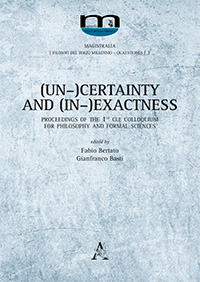Estratto da
(UN-)CERTAINTY AND (IN-)EXACTNESS
Proceedings of the 1st CLE Colloquium for Philosophy and Formal Sciences
Early apagogical inference forms: the rise of the reductio ad absurdum in the beginnings of ancient logic
(UN-)CERTAINTY AND (IN-)EXACTNESS
Proceedings of the 1st CLE Colloquium for Philosophy and Formal Sciences
Early apagogical inference forms: the rise of the reductio ad absurdum in the beginnings of ancient logic

This paper analyzes notions of consistency and inconsistency in the beginnings of Western philosophical thought. Philosophers have theorized on these themes within the logical-classical paradigm, as well as within non-classical logical paradigms (as is the case with the broad sense paraconsistent approach, as analyzed in Gomes (2013) and Gomes and D’Ottaviano (2010)). Heraclitus of Ephesus, one of the first to openly approach the problem, concluded that contradictions express in a clear and nontrivial way the true substratum of phenomena. Other solutions were adopted in the beginnings of the history of Western logic. In general, it may be affirmed that the idea predominated that the presence of contradictions is harmful to logically correct rational theories. Logical consistency, therefore, was considered to be an important feature of true rational theories, as opposed to false or trivial theories. Consistency (non-contradictoriness) was also chosen as an important element of the correct definition of being and of the ways of stating it, and of concepts and theories that express the true description of reality. Thus there gradually developed, from Parmenides to the Stoics, and with the distinct contribution of Plato and Aristotle, the theoretical-rational approach of logical-classical character. In this approach, with the aim of neutralizing the harmful power of contradiction, there was established, little by little, the strategy of refuting hypotheses which lead to contradictions – a strategy that was crystallized in the logical method of reduction to the absurd.
| pagine: | 141-178 |
| DOI: | 10.4399/97888255145135 |
| data pubblicazione: | Aprile 2018 |
| editore: | Aracne |








